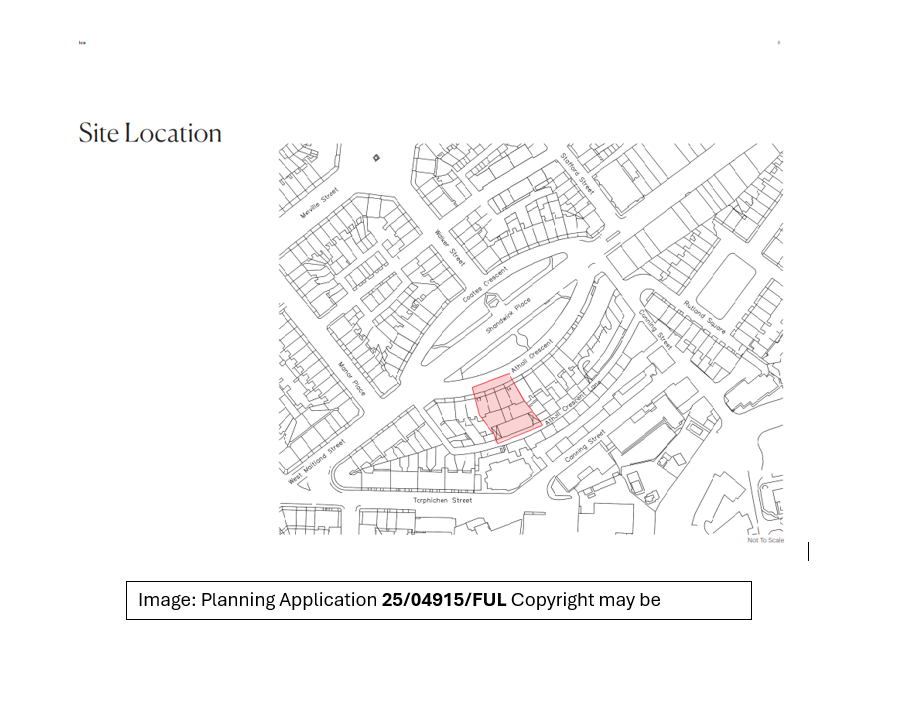Atholl Crescent
Posted on: October 31, 2025
Protect Atholl Crescent’s heritage; reject intensive transient pods, favour residential.
Address: 14 – 17 Atholl Crescent Edinburgh EH3 8HA
Proposal: Change of use from office to hotel including external alterations and associated works.
Reference No: 25/04915/FUL & 25/04916/LBC
Closing date for comments: Fri 31 Oct 2025 (LBC) & Fri 07 Nov 2025 (FUL)
Determination date: Sat 15 Nov 2025 (LBC) & Mon 24 Nov 2025 (FUL)
Result: Pending

Cockburn Response
The Cockburn Association wishes to begin by acknowledging the constructive engagement provided by the applicant. We are grateful for the opportunity to visit both the Atholl Crescent buildings and a completed example of the developer’s work on Victoria Street. These visits helped clarify the design intent and allowed useful discussion around the challenges of adapting historic fabric.
We also recognise the wider policy context and the need to broaden the city’s accommodation offer, particularly in terms of affordability and accessibility. Edinburgh benefits when visitor provision is diverse, inclusive, and sensitively integrated into the life of the city. Ensuring that people of varying incomes and mobility needs can stay in central Edinburgh is a legitimate aim, and one we do not dismiss.
However, following detailed review of the proposals, we must object. The buildings at Atholl Crescent are of the highest architectural and historical significance, forming part of a distinguished early nineteenth-century terrace within the New Town Conservation Area and the UNESCO World Heritage Site. While we acknowledge that some modern alterations have taken place internally, the terrace retains important elements of its original plan form, spatial hierarchy. The proposed intensive subdivision of principal spaces, installation of pod-style units and new services throughout, and associated physical interventions would, in our view, result in substantial and irreversible harm to the special architectural and historic interest of these Category A listed structures. This would be inconsistent with the requirements of the Historic Environment Policy for Scotland, which places great weight on protecting and enhancing cultural significance.
We are equally concerned about the high-density transient use proposed. Atholl Crescent and Atholl crescent Lane retain a residential character. The scale of occupation, turnover of guests, servicing needs, and late-night activity associated with this model of accommodation would introduce significant intensification into a location planned and built as a quiet domestic street. We do not believe that a pod-style hotel aligns with the character, amenity, or lived environment of this part of the New Town. In our view, this conflicts with policies in City Plan 2030 which require development to safeguard residential amenity and maintain balanced, sustainable communities.
A crucial material factor in this case is the existence of extant consent for a lower-density residential scheme. That consent demonstrates that a viable, heritage-appropriate future for these buildings already exists, one that restores their domestic character, supports a living community, and avoids the physical and operational pressures of intensive transient use. Our concern is therefore not an abstract wish to retain every former office building as housing, but the real-world comparison between two clearly identified paths: a settled residential restoration aligned with the historic form and community fabric of the Crescent, or a significantly more intensive visitor use with greater operational impacts and less obvious benefit to the character and wellbeing of the surrounding neighbourhood.
In this context, the key public-interest question remains unanswered: why should a far more intensive transient scheme be considered preferable to a viable consented residential use that would better sustain the New Town’s historic function as a lived-in community? We have not seen compelling evidence that such a shift would enhance the Outstanding Universal Value of the World Heritage Site or contribute positively to the long-term stewardship of these buildings.
We also note the absence of clear long-term heritage management and maintenance proposals, which are essential for buildings of such national importance.
For these reasons, we respectfully request that the applications be refused. We would be pleased to see revised proposals that protect the architectural integrity of the interiors, avoid over-intensification, and support the Crescent’s continued role as part of a living residential quarter. The Cockburn remains willing to work constructively with the applicant to explore a conservation-led scheme that secures the buildings’ future and maintains the character and community balance of this important part of the New Town.
